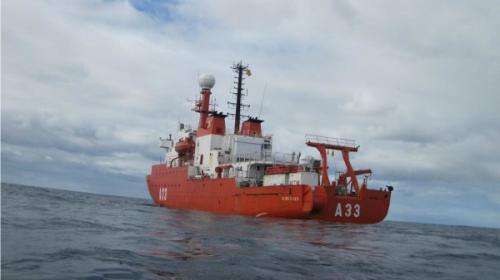Pollutants inhibit phytoplankton cell division

Phytoplankton are the ocean's most prolific primary producers, but new research shows environmental toxins are affecting cell division in the Prochlorococcus species.
The international study documents the effect of different doses of polycyclic aromatic hydrocarbons (PAHs)—pollutants produced by burning fossil fuels—on cell division in oceanic Prochlorococcus populations.
The research involved marine biologists Professor Susana Agusti and Maria Cerezo Sanchez sailing across the Atlantic, Indian and Pacific oceans on board the Spanish R/V Hesperides as part of the Malaspina-2010 expedition.
"Our goal was to test natural populations of Prochlorococcus for their sensitivities to PAHs," says UWA researcher, Prof Agusti.
"Laboratory strains are known to be more resistant to PAHs," she says.
Prochlorococcus is a small-celled picophytoplankton species, and one of the most abundant photosynthetic organisms on Earth.
"These tiny cyanobacteria are responsible for 25 per cent of the ocean's photosynthesis," Prof Agusti says.
The research team set up an incubation system on board the Hesperides to receive natural solar radiation and expose Prochlorococcus cells to their natural day-night cycle.
"The seas were so rough, waves hit the deck and equipment and glassware had to be tied to the lab benches," Prof Agusti says.
Lethal DNA damage
The scientists firstly quantified the abundance of Prochlorococcus by collecting daily water samples.
"We used two flow cytometers, which allowed us to identify and count the tiny Prochlorococcus cells," Prof Agusti says.
Treatments containing different PAH concentrations were added to the samples; no PAHs were added to the control group.
The researchers then monitored Prochlorococcus cell division in each sample by quantifying DNA replication and cell division phases.
Their results showed cells took longer to divide and grew more slowly following exposure to PAH doses greater than 1µg per litre.
"The most telling result of our research is that these microorganisms have a mechanism for repairing the DNA damage in cells when the concentration of PAHs is at sub-lethal levels, but higher doses stop the cell division process," says PhD candidate Maria Cerezo Sanchez.
PAH doses found to be lethal were higher than PAH concentrations in the open ocean, but comparable to concentrations along the coast, where researchers say Prochlorococcus growth is possibly inhibited.
"Coastal waters are most susceptible to large inputs of PAHs, due to human activities, river inputs and oil spills," Prof Agusti says.
"The ability of these toxins to inhibit the growth of important primary producers such as Prochlorococcus has global significance."
More information: Maria Isabel Cerezo, Susana Agustí, "PAHs reduce DNA synthesis and delay cell division in the widespread primary producer Prochlorococcus," Environmental Pollution, Volume 196, January 2015, Pages 147-155, ISSN 0269-7491, dx.doi.org/10.1016/j.envpol.2014.09.023.
Provided by Science Network WA


















